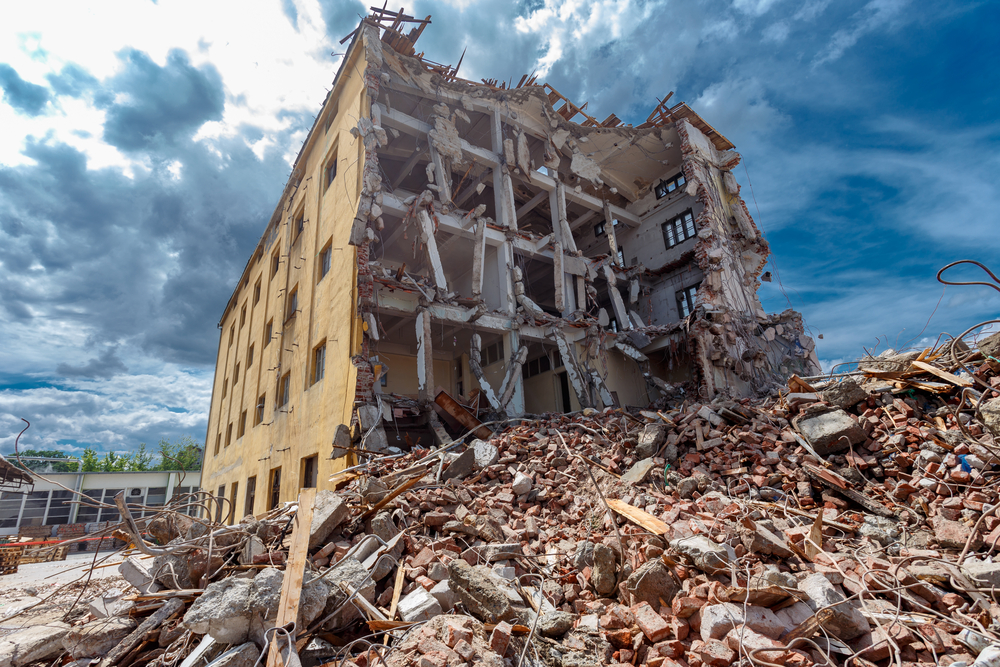Back to Basics is a weekly feature that highlights important but possibly overlooked information that any EHS professional should know. This week, we examine demolition hazards and OSHA’s demolition standards.
Demolition is a dangerous process that yields many worker injuries and fatalities. According to OSHA, the hazards of demolition work can be controlled and eliminated with proper planning, the right personal protection equipment (PPE), the necessary training, and compliance with OSHA standards.
Hazards
OSHA defines demolition as the dismantling, razing, destroying, or wrecking of any building or structure or any part thereof. Many demolition hazards are similar to construction work hazards, but with the addition of hazards due to unknown factors. These unknown factors may include changes from the structure’s design introduced during construction, and approved or unapproved modifications that altered the original design.
There could be materials hidden within structural members, such as lead, asbestos, silica, and other chemicals or heavy metals that require special material handling procedures. Construction materials could have unknown strengths or weaknesses, such as post-tensioned concrete. The demolition process itself also creates a set of hazards depending on the method being used.
OSHA recommends combating these hazards by making sure everyone at the demolition worksite is fully aware of the hazards they may encounter, and the safety precaution they should take to protect themselves and their employees.
Employer responsibility
Employers must take three main steps to help prevent demolition incidents, says OSHA. The first step is to plan ahead to get the job done safely. Proper planning is essential to ensure that a demolition operation is conducted with no incidents.
Proper planning includes having a competent person complete an engineering survey before any demolition work is done, and the survey must include the condition of the structure and the possibility of an unplanned collapse. An assessment of health hazards must also be completed before work begins. Employers must locate, secure, and potentially relocate any nearby utilities, and they must have a fire prevention and evacuation plan and access to first aid and emergency medical services.
The second step is providing the right protection and equipment. According to OSHA, employers are responsible for determining and selecting the proper PPE required for demolition operations. PPE could include eye, face, head, hand, and foot protection, respiratory protection, hearing protection, and personal fall arrest systems (PFAS). Other kinds of protective equipment may also be used in cases of cutting or welding operations.
The third step is training. Employees must be trained in all demolition hazards and how to use demolition equipment safely. They must also learn the proper selection, use, fitting, inspection, maintenance, and storage of PPE.
Preparation
OSHA’s demolition standard states that before demolition operations can begin, a competent person must conduct an engineering survey that determines the condition of the framing, floors, and walls of the structure, and the possibility of unplanned collapse. Adjacent structures that employees might be exposed to must also be checked, and employers are responsible for having written evidence that the survey has been performed.
If workers are required to demolish a structure that has been damaged by fire, flood, explosion, or another cause, the walls or floor must be shored or braced. All electric, gas, water, steam, sewer, and other service lines must be shut off, capped, or controlled, before demolition begins, and any utility company involved must be notified in advance. Additionally, if any power, water, or other utilities need to be maintained during demolition, such lines should be temporarily relocated as necessary and protected.
Employers must decide if any type of hazardous chemicals, gases, explosives, flammable materials, or similarly dangerous substances have been used in any pipes, tanks, or other equipment on the property. If this is the case and these substances are present or suspected, testing and purging must be performed, and the hazard eliminated before demolition begins.
If a hazard exists from fragmentation of glass, it must be removed, and where a hazard exists that could allow employees to fall through wall openings, the opening must be protected to a height of approximately 42 inches, says OSHA.
If debris is dropped through holes in the floor without using chutes, the area where the material is dropped must be completely enclosed with barricades not less than 42 inches high and not less than 6 feet back from the projected edge of the opening above. Signs containing a warning of falling materials must be posted at every level, and removal must not be permitted in the lower area until debris handling ceases above.
All floor openings not being used as material drops should be covered with material substantial enough to support the weight of any imposed load, and such material must be properly secured to prevent accidental movement.
Demolition of exterior walls and floor construction should begin at the top of the structure and proceed downward, with the exception of cutting holes in the floors for chutes for dropping materials, preparation of storage space, and other preparation work. Each story of exterior wall and floor construction should be removed and dropped into the storage space before the removal of exterior walls and floors in the story below begins.
Lastly, employee entrances to multi-story structures being demolished must be completely protected by sidewalk sheds or canopies, or both, to provide protection from the faces of the building for a minimum of 8 feet. All canopies should be at least 2 feet wider than the building entrances and openings, meaning 1 foot wider on each side, and they must be capable of withstanding a loaf of 150 pounds per square foot.
For more information, click here to read OSHA’s full guidance on demolition.

